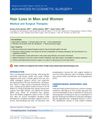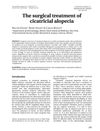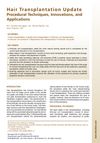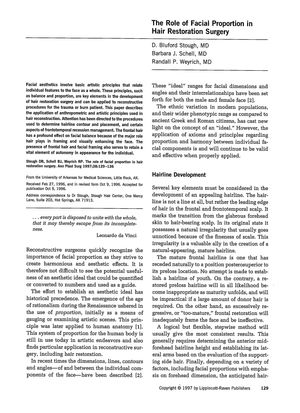TLDR The document concludes that successful hair restoration surgery should consider facial proportions and balance, and requires surgical skill, artistic judgment, and realistic goals for a natural look.
The 1997 document highlights the significance of facial proportion and balance in hair restoration surgery, focusing on the design of hairlines to frame the face appropriately. It recommends positioning a mature hairline posterosuperior to its original location, typically 8 to 9 cm above the glabella, while considering factors like age, hair loss pattern, and donor hair availability. The paper stresses the need for surgical skill, medical judgment, and artistic ability to achieve successful outcomes, and advises against following fashion trends due to the permanence of hair transplantation. It also notes that aging changes and facial features such as a long nose or chin may require adjustments to the hairline. The authors emphasize the importance of realistic goal-setting and patient counseling to ensure long-term satisfaction and a natural appearance, which is also beneficial for trauma and burn patients.
 10 citations
,
December 1997 in “Plastic and Reconstructive Surgery”
10 citations
,
December 1997 in “Plastic and Reconstructive Surgery” Hair restoration surgery has improved with better techniques for natural looks and managing patient expectations, but it remains labor-intensive and requires careful consideration of potential complications.
 5 citations
,
February 2019 in “Oral and Maxillofacial Surgery”
5 citations
,
February 2019 in “Oral and Maxillofacial Surgery” Hair loss can be reversed or even cured using advanced hair restoration techniques, with rare complications like swelling and bleeding.
 April 2019 in “Advances in Cosmetic Surgery”
April 2019 in “Advances in Cosmetic Surgery” The document concludes that ongoing medical therapy is crucial for preventing hair loss, and surgical options can restore hair, with future treatments for hair loss being promising.
 51 citations
,
July 2008 in “Dermatologic Therapy”
51 citations
,
July 2008 in “Dermatologic Therapy” The document concludes that surgery is a preferred treatment for cicatricial alopecia, with the method chosen based on individual factors and may require multiple sessions and careful postoperative care.
 7 citations
,
July 2014 in “Facial Plastic Surgery Clinics of North America”
7 citations
,
July 2014 in “Facial Plastic Surgery Clinics of North America” Different ethnic hair traits must be considered for successful hair restoration surgery to achieve natural-looking results.
 26 citations
,
October 2012 in “Dermatologic Clinics”
26 citations
,
October 2012 in “Dermatologic Clinics” The document details hair transplantation techniques and innovations, highlighting Follicular Unit Transplantation as the standard and discussing the effectiveness and challenges of the procedure.







